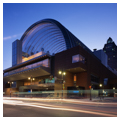The Kimmel Center has the ungainly grace of an aircraft carrier moored at Broad Street, with its largely opaque hull at street level and visible life restricted to the flight deck overhead. The conceit even extends to the odd overhanging canopies that instead of providing shelter have the appearance of external elevators that convey planes from the hull to the deck. Above, is an even less convincing mixture of nineteenth-century forms: the train shed or Crystal Palace–like main roof that covers the interior plaza and the performance halls, surrounded by red brick that was presumably intended as a gesture to context but ends up being too dull and too dark to fit into its setting. Completed in 2002, it is part of the worldwide movement that has transformed art institutions into markers of civic identity. In this instance, the identity feature—the great overarching roof—squeezes the concert hall, which caused the loss of seating that is partially made up by a lack of aisles and not enough restrooms on the public levels of the building. Hopefully, they won't play Handel's Water Music too frequently.
The bloated lines of the roof structure contrast with the structural elegance of Wilson Brothers’ train shed for the Philadelphia and Reading Railroad Terminal (PH45), while the juxtaposition of Viñoly's overbearing volume with the staid simplicity of the nearby American Academy of Music (PH58) is equally instructive. Within, the concert halls rely on the modern conventions of materiality—in agonizingly thin wood veneers that have the appearance of photo vinyl—rather than the craft of paint and plaster of nineteenth-century public space. Verizon Hall—everything is named for a product—has something of the feel of being inside a cello or a double bass with its double-curved wood walls, while the blonde woods and dark contrasts of the smaller Perelman Hall have a more retro feel.
Of the other buildings that made S. Broad Street the city's civic zone in the mid-nineteenth century, a few survive to the south, including the rather flattened Gothic Revival of the Chambers-Wylie Memorial Presbyterian Church (1899) by Rankin and Kellogg at 315 S. Broad Street, which commemorates in its name the congregations formed by two of the city's most flamboyant preachers.







